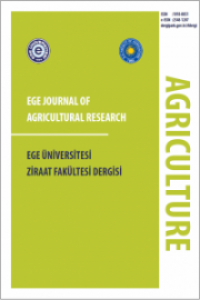The modelling of rupture force of white kidney beans (Phaseolus vulgaris L.) using the multiple linear regression (MLP) and artificial neural networks (ANN)
Abstract
Objective: The
objective of this study modelling the rupture force of white kidney beans with the
multiple linear regression (MLR) and artificial neural networks (ANN).
Material and Methods: It
was used four different white kidney bean varieties (Akman, Topçu, Göynük and Karacaşehir) at the
five different moisture contents (14.28%, 24.32%, 33.45%, 42.54% and 53.48%).
In the MLR and ANN models the moisture contents, length, width, thickness, arithmetic mean
diameters, geometric mean diameters, surface area and sphericity of the beans were used as input
parameters while the rupture force as output parameter. In addition, 24
different ANN architectures were used in the ANN.
Results: The
highest R2 values for the Akman (0.979) and Karacaşehir (0.986) varieties
were obtained in the ANN11 architecture used by the Levenberg-Marquard learning
function and the logarithmic sigmoid - linear transfer function pairs with 12
neurons. However, the best prediction values for Topçu (0.963) and Göynük
(0.944) were obtained in ANN 7 and ANN 2 architectures, respectively. In
addition, the best pair of learning functions for Topçu and Göynük were
observed in Logarithmic sigmoid - Symmetric sigmoid and Logarithmic sigmoid-
linear transfer functions, respectively.
Conclusion:
The results of the study clearly showed that the ANN successfully modeled
rupture force in all the white kidney bean varieties.
References
- ASAE (1999). Moisture measurement – unground grain and seeds. S352.2, DEC97.ASAE Standards, Standards Engineering Practices Data. ASAE, St. Joseph, MI.Droulia F, Lykoudis S, Tsiros I, Alvertos N, Akylas E , Garofalakis I (2009). Ground temperature estimations using simplified analytical and semi-empirical approaches. Solar Energy 83: 211-219
- Emamgholizadeh S, Parsaeian M, Baradaran M (2015). Seed yield prediction of sesame using artificial neural network. European Journal of Agronomy 68: 89-96.Erenturk S, Erenturk K (2007). Comparison of genetic algorithm and neural network approaches for the drying process of carrot. Journal of Food Engineering 78: 905–912.
- Franch LJ, Panigrahi S (1997). Artificial neural network models of wheat leaf wetness. Agricultural and Forest Meteorology 88: 57—65.Gardner MW, Dorling SR (1998). Artificial neural networks (the multilayer perceptron) - a review of applications in the atmospheric science. Atmospheric Environment 32: 2627-2636.
- Gevrekçi Y, Yeğenoğlu E, Akbaş Y, Sesli M (2011). Yapay sinir ağlarının tarımsal alanda kullanımı. Ege Üniversitesi Ziraat Fakültesi Dergisi, 48(1): 71-76. Hernandez-Perez JA, Garcia-Alvarado MA, Trystram G, Heyd B (2004). Neural networks for heat and mass transfer prediction during drying of cassava and mango. Innovative Food Science Emergency Technology 5:57–64.
- Javad Khazaei J, Shahbazi F, Massah J, Nikravesh M, Kianmehr M (2008). Evaluation and modeling of physical and physiological damage to wheat seeds under successive impact loadings: mathematical and neural networks modeling. Seed physiology, production & technology 48(4):1532-1544
- Kerdpiboon S, Kerr WL, Devahastin S (2006). Neural network prediction of physical property changes of dried carrot as a function of fractal dimension and moisture content. Food Research International 39: 1110–1118.
- Latrille E, Corrieu G, Thibault J (1993). pH prediction and final fermentation time determination in lactic acid batch fermentations. Escape 2. Computer Chemical Engineering 17: 423–428.
- Martynenko AI, Yang SX (2006). Biologically inspired neural computation for ginseng drying rate. Biosystems Engineering 95 (3): 385–396.
- Movagharnejad K, Nikzad M (2007). Modelling of tomato drying using artificial neural network. Computers and Electronics in Agriculture 59: 78–85
- Nimkar PM, Mandwe DS, Dudhe RN (2005). Physical properties of moth gram. Biosystems Engineering 91 (2): 183–189.
- Nizian M. Noori S, Abdipour M (2018). Modeling the seed yield of Ajowan (Trachyspermum ammiL.) using artificial neural network and multiple linear regression models. Industrial Crops & Products 117:224-234
- Sehirali S (1988). Edible Pulses. Publications of Agricultural Faculty of Ankara University No: 1089. Ankara/Turkey (in Turkish).
- Sivrikaya O (2009). Comparison of artificial neural networks models with correlative works on undrained shear strength. Eurasian Soil Science 42 (13): 1487–1496.
- Sologubik CA, Campa˜none LA, Pagano AM, Gely MC (2013). Effect of moisture content on some physical properties of barley. Industrial Crops and Products: 43:762– 767
- Sun DW, Woods JL (1994). Low temperature moisture transfer characteristics of barley: thin-layer models and equilibrium isotherms. J. Agric. Eng. Res. 59: 273–283
- Trelea IC, Raoult-Wack AL, Trystram G (1997). Application of neural network modelling for the control of dewatering and impregnation soaking process (osmotic dehydration). Food Science and Technology International 3:459–465
- Van Wijk M , Bouten T, Verstraten J M (2002). Comparison of different modeling strategies for simulating gas exchange of a douglas-fir forest. Ecological Modeling 158: 63—81
Details
| Primary Language | English |
|---|---|
| Subjects | Engineering |
| Journal Section | Articles |
| Authors | |
| Publication Date | March 31, 2020 |
| Submission Date | April 17, 2019 |
| Acceptance Date | October 15, 2019 |
| Published in Issue | Year 2020 Volume: 57 Issue: 1 |

